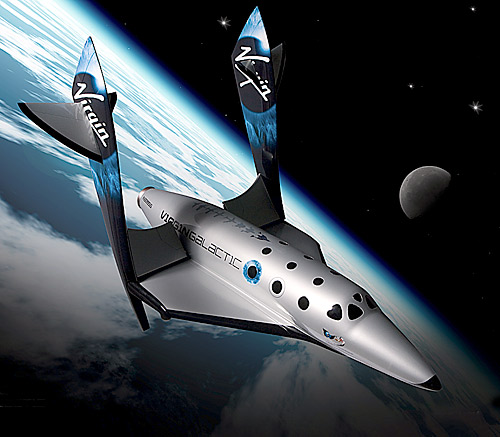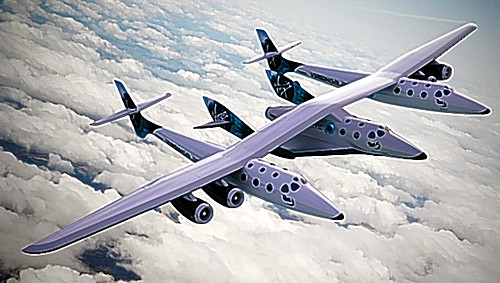The biggest twist is that the WhiteKnightTwo plane has spread out and sprouted another passenger cabin on its 140-foot-long wing. The two cabins and four Pratt & Whitney jet engines straddle a central mount for the rocket plane, which will be carried to an altitude of 50,000 feet and dropped. Then SpaceShipTwo will light up its hybrid rocket engine for the final push to the edge of outer space.
Virgin Galactic says it thinks it could launch small satellites in the range of 50-100kg into low-Earth orbit using an unmanned rocket hung from White Knight Two for less than $2.5m.
They have spent $70m already and will spend another $130 million. Virgin Galactic expects to break even in 2014. Reducing the price of a trip into space to attract more customers is also part of the plan, as is exploiting every possible form of additional income, such as selling media rights.
Live coverage from Wired of the event
I think a related news is that on Feb 12-13 there will be “leaders of the space community” who will look at forming an alternative to the Lunar Vision for Space Exploration centered around manned asteroid landings. If alternative-vision planners have their way, the mission could instead be flown to an asteroid in about 2025 as opposed to the original and uncertain 2020 target for a lunar landing. The contrast between NASA plans and Virgin galactic will be discussed below.

Artistic representation of Scaled Composites spaceshiptwo in space. Eight seater craft, seating 2 pilots and 6 passengers, which will be used by Virgin Galactic passengers.

White Knight 2
The new White Knight 2 mothership, says Whitehorn will have four jet engines and is a significant departure from the first White Knight.
The mothership is 70 percent complete and will be the largest all-carbon-composite airplane in the world. Test flights are expected to begin this summer.
More on the shifting Nasa plans:
The asteroid visit and Lagrangian mission concepts would use much of the same CEV Ares I and Ares V heavy-lift booster infrastructure, but in ways that would be much faster stepping-stones to Mars than developing a manned lunar base. Asteroid and Lagrangian point missions would each last several weeks or months. Both the libration points and asteroids would be about 1 million mi. from Earth, requiring operations more like much longer trips to Mars at least 40-100 million mi. away.
Robotic options for all mission elements also will be reviewed, and one working group will be devoted to better defining manned versus robotic tradeoffs.

White Knight 2 model
Contrast of Nasa plans with Virgin Galactic.
Nasa plans if they are successful do not achieve the main program milestones until 2025 or 2020. Virgin Galactic could start flying passengers in late 2009.
Virgin Galactic could expand the number of people (passengers) who get to fly by 10 to 1000 times versus the NASA plans. Seats on spaceshiptwo cost $200,000. Virgin Galactic says more than 200 individuals have booked, and another 85,000 have registered an interest to fly. Tens of millions of dollars in deposits have already been taken. If set prices drop to $100,000 each then 85,000 people would generate $8.5 billion in revenue. This could make spaceshipthree (an orbital system) fully fundable from Virgin Galactic operational profits.
Virgin Galactic appears to be offering a path forward to safer (100 times or more safer) and cheaper travel into space for a lot more people. NASA plans are for multi-billion new hardware (which does not have interesting new capabilities beyond what is currently available) and on the ground jobs for the current bureaucracy and plans for a few elite astronauts to go on short term missions.
Virgin Galactic has systems that leverage and build upon the best of what has gone before. NASA plans restart development every few years and costs are constantly escalating.
NASA plans are centered around justifying building the CEV Ares I and Ares V heavy-lift booster infrastructure. Before that it was around justifying building the International Space station. Before that it was around justifying the Hubble Space telescope and the Space shuttle. The hardware should be about supporting the missions and finding ways to increase safety and lower costs and expand capability.
NASA should look at shorter development cycles. What can NASA deliver in 4 years that can reduce costs and add new capability ?
Missions for better propulsion (better ion drive, Vasimr, laser array launches etc…). Fuel efficient electric engines for LEO to moon, langrange points, asteroids etc…
Development of space mining and resource utilization. Generating oxygen from regolith etc…

Brian Wang is a Futurist Thought Leader and a popular Science blogger with 1 million readers per month. His blog Nextbigfuture.com is ranked #1 Science News Blog. It covers many disruptive technology and trends including Space, Robotics, Artificial Intelligence, Medicine, Anti-aging Biotechnology, and Nanotechnology.
Known for identifying cutting edge technologies, he is currently a Co-Founder of a startup and fundraiser for high potential early-stage companies. He is the Head of Research for Allocations for deep technology investments and an Angel Investor at Space Angels.
A frequent speaker at corporations, he has been a TEDx speaker, a Singularity University speaker and guest at numerous interviews for radio and podcasts. He is open to public speaking and advising engagements.


Comments are closed.